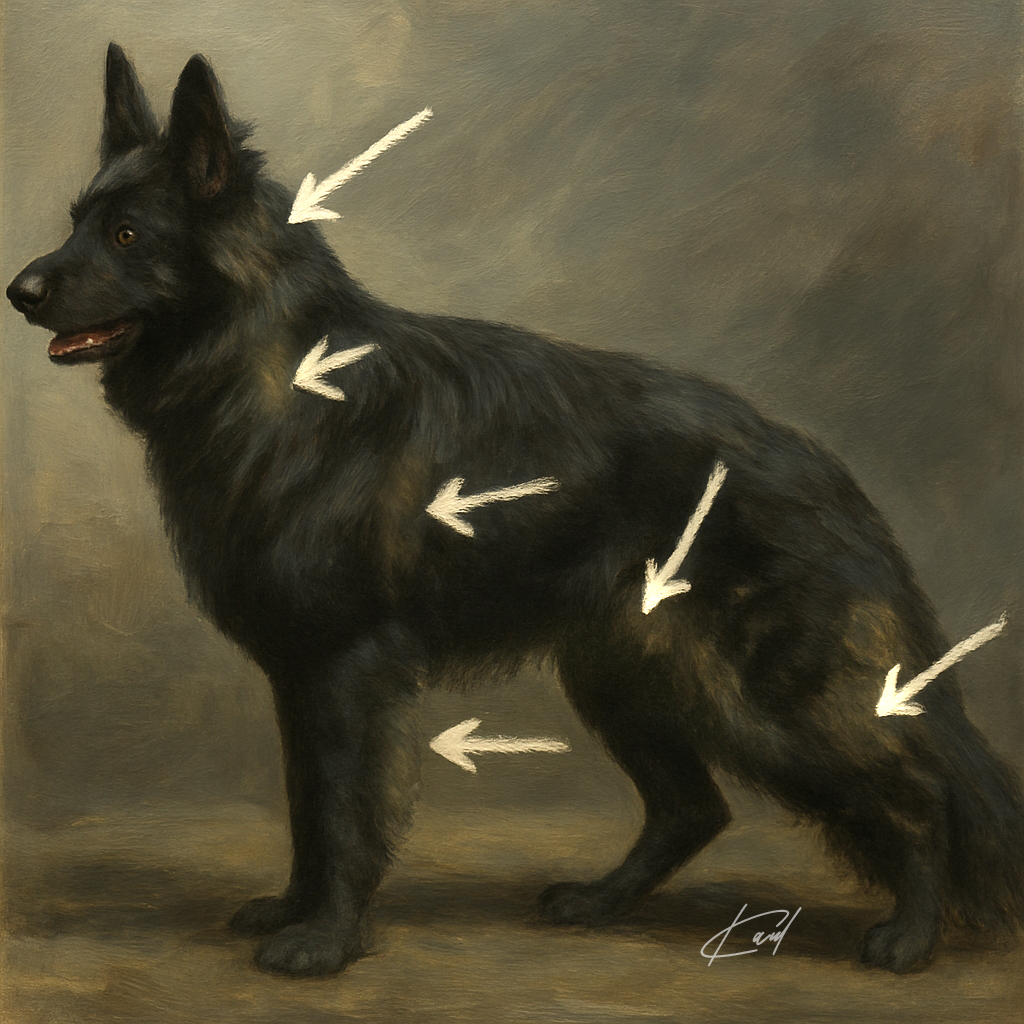Dominant Black German Shepherd? Why KB Dogs aren’t Breed Typical
Intro
The dominant black German Shepherd—caused by the KB allele at CBD103—is often confused with the classic solid black GSD, yet the two are genetically different. In this post, we make the case that KB-based dominant black is not a breed-typical color pathway for German Shepherd Dogs, and that it functions as a masking gene similar in principle to disallowed white or the “Panda” pattern. If the mission is to preserve the GSD’s true genetic palette and evaluate pigment honestly in the ring, KB should be treated as a disqualifying fault.
The two routes to “black” in GSDs: recessive a/a vs. dominant KB
- Breed-native black: For over a century, solid black GSDs have been produced by recessive black (a/a) at the ASIP (A) locus. This is the traditional pathway in the breed and does not rely on an external masking switch.
- Dominant black: In contrast, KB at CBD103 (the K locus) is a separate mechanism that masks A-locus patterns (sable, saddle, bicolor). It’s epistatic—like pulling a blackout curtain over the pattern we’re supposed to judge.
Why that matters: Conformation evaluates pigment quality and distribution (mask, saddle, sable gradients). When a color mechanism masks the pattern, judges can’t fairly assess the traits the standard values.
“If white is out, KB should be out”—consistency with masking rules
The SV/FCI standard disallows white because it masks pigment and markings. The same logic applies to KB dominant black: it’s another masking route, just in black instead of white. By consistent rules, allowing KB while banning white (or Panda) is contradictory. If the aim is preservation—not novelty—KB doesn’t belong in the ring.
Mendel’s peas, not magic: how KB inherits (and why “bleed-through” happens)
Think simple Punnett squares:
- KB/ky × ky/ky (dominant-black parent × normal black-red parent)→ ~50% KB/ky and ~50% ky/ky. No KB/KB puppies possible from this pairing.
- KB/ky × KB/ky→ 25% KB/KB, 50% KB/ky, 25% ky/ky.
What you’ll see in the ring: single-copy KB (KB/ky**) dogs often show “bleed-through”**—small white or pale areas on chest/toes or “seal” edging—which can become more noticeable with age. That doesn’t happen with classic recessive-black (a/a) GSDs.
Why we believe KB is not GSD-native
The KB variant (CBD103 ΔG23) is shared across multiple breeds. A recent brief report identified KB in a small set of GSDs, noting heterozygotes (KB/ky) had undesired markings not typical of recessive blacks and adding, “We can only hypothesize how this variant was introduced into this breed.” In other words, even the geneticists didn’t treat KB as a long-standing, internal GSD pathway. After ~120 years of breed history, the sudden appearance of an identical, cross-breed variant looks more like introgression than a novel mutation popping up in GSDs.
“Dominant black” isn’t just a color—it’s a mask that blocks evaluation
Allowing KB effectively swaps white masking for black masking and still prevents us from evaluating pigment strength and pattern fidelity. If the standard prohibits colors that obscure true pigment assessment, it should also bar KB dominant black. By that same logic, patterns like Panda—also masking and non-standard—remain out.
The Nummer-Eins position (and what we breed)
At Nummer-EIns German Shepherds, we select for functional, breed-typical structure and pigment. We accept and appreciate solid black GSDs produced by recessive a/a—a native pathway consistent with the breed’s history. We do not support introducing KB into the gene pool, and we advocate that KB dominant black be treated as disqualifying in conformation.
Buying or breeding? Ask for DNA color testing that distinguishes recessive a/a from dominant KB at the K locus. If you’re evaluating an all-black youngster from a dominant-black × black-red mating, remember: KB/KB is genetically impossible from that pairing; if the puppy is truly uniform black without bleed-through as it matures, recessive a/a is the more plausible explanation.
Key takeaways
- True, breed-native black in GSDs = recessive a/a at the A locus.
- Dominant black (KB) at CBD103 is a masking switch that blocks fair pigment/pattern evaluation.
- If white is disallowed for masking, KB should be disallowed for the same reason.
- Single-copy KB often shows bleed-through over time; KB/KB requires two KB parents.
- Evidence and logic suggest KB is not a historical GSD pathway and likely entered from outside.
FAQs (for readers and search intent)
Q1: Are solid black German Shepherds acceptable?
Yes—when they’re recessive black (a/a) at the A locus, which is historically breed-typical.
Q2: What is “dominant black” in GSDs?
Dominant black is caused by the KB allele at CBD103. It masks the A-locus pattern, creating an all-black look by covering the underlying color map.
Q3: Can DNA testing tell KB from a/a?
Yes. Modern panels report A-locus (ASIP) status and K-locus (CBD103) status separately, allowing you to distinguish a/a from KB carriers.
Q4: Why is KB a problem if the dog looks black either way?
Conformation evaluates pigment quality and distribution. KB masking hides what judges need to see, just as white masking does.
Q5: Should dominant black be allowed in the show ring?
Our position: No. If white and Panda are excluded for masking, KB should be treated the same to preserve breed-typical genetics and honest evaluation.
References
- K-locus discovery (CBD103/β-defensin): https://onlinelibrary.wiley.com/doi/10.1111/j.1365-2052.2007.01664.x
- Brief report noting KB in GSDs and “undesired markings”: https://onlinelibrary.wiley.com/doi/10.1111/age.13154
- ASIP (A-locus) and coat color background: https://www.ncbi.nlm.nih.gov/pmc/articles/PMC2906624/
- A β-Defensin Mutation Causes Black Coat Color in Domestic Dogs: https://pmc.ncbi.nlm.nih.gov/articles/PMC2906624/

